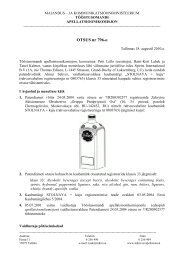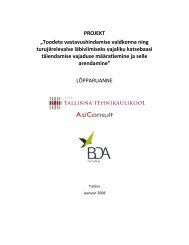Feasibility study for an Estonian Materials Technology Programme
Feasibility study for an Estonian Materials Technology Programme
Feasibility study for an Estonian Materials Technology Programme
You also want an ePaper? Increase the reach of your titles
YUMPU automatically turns print PDFs into web optimized ePapers that Google loves.
48<br />
<strong>Feasibility</strong> <strong>study</strong> <strong>for</strong> <strong>an</strong> Estoni<strong>an</strong> <strong>Materials</strong> <strong>Technology</strong> <strong>Programme</strong><br />
2. <strong>Materials</strong> technology in Estonia<br />
2.4.6 Textiles industry<br />
Industry background<br />
Textiles industry has traditionally been very strong in Estonia <strong>an</strong>d it still employs approximately 14 000 people<br />
(~13% of the total industrial work<strong>for</strong>ce) <strong>an</strong>d generates 7% of the whole industrial production. The industry<br />
accounted <strong>for</strong> 5% of all Estoni<strong>an</strong> exports in 2007.<br />
Main product groups of the Estoni<strong>an</strong> textile industry are clothing, home textiles <strong>an</strong>d technical textiles. Main<br />
export articles are clothes, home textiles <strong>an</strong>d knitted garments. The Estoni<strong>an</strong> Clothing <strong>an</strong>d Textile Association<br />
(ECTA) divides the sector into clothing <strong>an</strong>d textiles subsectors in its statistics. By this division, clothing corresponds<br />
to approximately 38% of total industry production whereas the share of textiles production is 62%.<br />
The majority of people in textiles industry are, however, employed by clothing comp<strong>an</strong>ies that employ almost<br />
10000 people compared to other textiles production that employs close to 6000 people (2008 figures). The<br />
number of employees has dramatically decreased during the last years as the employee count has declined<br />
almost 50% from the peak years in 2001-2003 when almost 25000 people were employed by the industry.<br />
The breakdown between the subsectors is somewhat different th<strong>an</strong> the situation in the EU, where clothing<br />
accounts <strong>for</strong> 41% of total textiles industry production. The clothing industry in Europe is in difficult position<br />
due to the price pressure coming from low cost countries, especially in Asia. Thus it is generally acknowledged<br />
that the industry needs to clearly focus in high added value products in the future, where different technical<br />
textiles <strong>an</strong>d products integrated with other materials groups play a key role. In Estonia, a very large share of<br />
non-clothing producing comp<strong>an</strong>ies is producing home <strong>an</strong>d interior textiles <strong>an</strong>d there is very little production<br />
of industrial or technical textiles. In the interviews of key Estoni<strong>an</strong> stakeholders, Ilves Ekstra <strong>an</strong>d Toom Tekstiili<br />
were mentioned among comp<strong>an</strong>ies more oriented to higher value added technical textiles.<br />
Clothing 41 %<br />
Figure 9. Breakdown of textile industry sectors by fiber usage in Europe 41<br />
Among the 500 largest comp<strong>an</strong>ies in Estonia, there are four textiles industry comp<strong>an</strong>ies. The largest comp<strong>an</strong>ies<br />
by far in the industry are Silv<strong>an</strong>o Fashion group producing lingerie <strong>an</strong>d Wendre that produces various<br />
home textiles. Other two textiles producers among the largest comp<strong>an</strong>ies are Toom Tekstiili that produces<br />
home textiles <strong>an</strong>d non-woven textiles <strong>for</strong> different purposes such as industrial <strong>an</strong>d technical use. The fourth<br />
largest comp<strong>an</strong>y, Mivar, is also producing home textiles.<br />
Textile industry trends<br />
Industrial <strong>an</strong>d technical textiles 26 %<br />
Home & interior textiles 33 %<br />
The key trend in textile industry, especially <strong>for</strong> Europe, is the focus on adding more value to textile products<br />
<strong>an</strong>d focusing the industry more on technical textiles. The strategic research agenda of the Europe<strong>an</strong><br />
<strong>Technology</strong> Plat<strong>for</strong>m <strong>for</strong> the Future of Textiles <strong>an</strong>d Clothing outlined three major development trends:<br />
From commodities towards specialities (along the entire value chain)<br />
New textile applications (<strong>for</strong> different industrial sectors <strong>an</strong>d application fields)<br />
Towards customisation (rather th<strong>an</strong> mass m<strong>an</strong>ufacturing)<br />
The textile industry <strong>an</strong>d value chains are very complex as c<strong>an</strong> be seen in Figure 10, which represents the textile<br />
industry value chain from fibre production to recycling of the final product. The raw materials of the industry<br />
are natural fibres but also m<strong>an</strong>-made fibres of e.g. polymers. The intermediate products – thread, fabric <strong>an</strong>d<br />
garment – are used by three notable subsectors including clothing, home textiles <strong>an</strong>d various industrial applications.<br />
41 http://www.euratex.eu/system/files/attached-files/broch-sra-def.pdf





